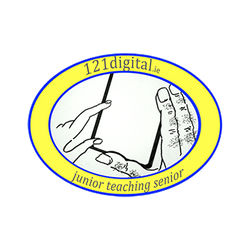Learn More
There are 3 groups needed to run the 121digital Programme:
1. Learners
These can be people of all ages who want to upgrade their digital skills - maybe to learn more about their new tablet, smartphone or laptop. Whatever they wish to learn, a programme will be tailored to their needs and all levels can be catered for.
2. Tutors
These are the ‘digital natives’, who can share their digital skills and thrive on the opportunity to teach and share their expertise. Tutors can include transition year students as part of their TY programme, third level students and other members of the community who are passionate about helping others.
3. Facilitators
They organise the 121digital lessons by guiding and supporting the Tutors and Learners, applying the content and structure of the 121digital course. You might be part of one of these groups, you might work with them in your community or maybe you just know they exist! In any case, if you think 121digital could improve wellbeing in your community, have a look at the curriculum to learn more about how it works.
You might be part of one of these groups, you might work with them in your community or maybe you just know they exist!
In any case, if you think 121digital could improve wellbeing in your community, have a look at the curriculum to learn more about how it works.
See Course in Action
The course is delivered in more than 70 schools, universities, libraries and companies around the country over a 4 or 6 week period.
Content in the form of professionally prepared Tutor Guides consists of 17 documents providing content, tips, guidelines and links to support Tutors in their role as teacher. Learners can choose their own learning topics e.g. Gmail, Internet Banking, Skype, Shopping Online, Accessing Government Services Online, Social Networking, etc.
Tips
Seeing the course in action will bring it to life and make it easier for you to describe the potential impact to schools. If you can't travel, talking to someone who has experience will also be helpful.
Learners are given a 60 page full-colour Learners' Handbook for the duration of the course.
Now that you know more about what’s involved and how the course works, would you like to speak to someone that has already been involved and experienced 121 firsthand?
Or even better, would you like to see the course in action? Check if 121 Digital is operating in a centre near you here: List of 121digital Centres
Find a venue
Depending on the structure of your programme (in a secondary school as part of the TY programme, in a university/library/community centre/youth club, you should find a suitable venue to hold the course.
In schools and universities, the course would typically run in any room (not the computer room/lab). In a community setting, the course could be run in a public library. Just make sure you have an internet connection! If you're looking to run the programme as part of the transition year programme in a secondary school, it's a good idea to arrange a meeting to introduce the idea to the school. It’s generally best to speak to the principal of the school as this is typically where the decision making lies. However, you can also talk to the deputy principal, the TY Coordinator or another teacher. Explain why you think this programme could benefit both the school and the community as a whole.
The venue should be free, so try utilise community-oriented buildings such as schools, libraries, community centres.
If you're looking to run the programme as part of the transition year programme in a secondary school, it's a good idea to arrange a meeting to introduce the idea to the school. It’s generally best to speak to the principal of the school as this is typically where the decision making lies. However, you can also talk to the deputy principal, the TY Coordinator or another teacher. Explain why you think this programme could benefit both the school and the community as a whole.
Visit
Someone from 121digital can accompany you to the school meeting or just give you some tips before your visit.
When planning to talk to your local school, remember that schools are often looking for new ways to engage meaningfully with the community and also to equip students with new and interesting opportunities. 121digital ticks both these boxes!
Some of the benefits that have been proven in schools already using the programme include:
- for TY students: they learn how to teach (one person at a time), the experience gives them an appreciation for the work of the teachers in the school and they get the opportunity to connect with older members of the community cultivating intergenerational and interpersonal skills.
- for the school: they get to contribute to the local community in a meaningful way by welcoming new learners to the school and equipping students with a unique and enhancing experience.
Sometimes the teachers or principal in the school might like to be put in touch with teachers in schools that have already used the programme. If so, just let us know and we’d be delighted to help you make this happen.
Agree a Plan
Once you've secured a venue and you're excited about the programme, you should agree a plan to get started. The most important things to consider are: Timeline - the course takes 6 weeks so try to plan for a period that won’t be interrupted by school holidays, mid-term breaks, Christmas, Easter etc. Start date - you should agree a start date to focus your preparation and make sure you have everything in place in plenty of time. WiFi - it’s very important that the venue has a good wifi connection. This isn’t guaranteed and shouldn’t be taken for granted so don’t forget to double check with the venue.
Facilitators - you’ll need a few Facilitators to help run the classes (ideally 2). Maybe you’ll be a Facilitator yourself or you know some people that will be willing to help out. Facilitators will need to complete a Garda vetting form, you can find out more about the Garda vetting process here and the school will help you with the administrative process. Advertising will need to be done locally to recruit your Learners. These are the people who will avail of the classes. You can advertise in local shops, newsletters, local media and 121digital can also help you with advice and guidance.
Recruit Tutors and Prepare Training Materials
In a school setting, the Transition Year Coordinator will help to recruit Tutors - i.e. the students who will share their digital skills. Generally 95% of students opt to take part in the programme and it’s good to give students a choice to make sure they’re genuinely interested.
In a broader community setting - in a university or public library, you can recruit tutors from many areas! Reach out to third level colleges and ask them to include a little piece on 121digital and that you're looking for volunteers. Contact local media, newsletters, even post on Facebook. You'd be surprised how many people will share your post and offer to get involved!
Tutors will receive an hour of training before getting started and a suite of guides to support them to deliver the lessons. Learners will receive their Learner’s handbook to use for the duration of the course.
121digital will provide you with all of these materials once you’re ready to get started.









 "Welcome to the ChangeX 121digital guide!We're delighted you're thinking about getting theprogramme started in your community. Here you’llfind all the information, tips and resources youneed. We're here to help so don't be afraid to get intouch!"
- Fintan Mulligan, Founder of 121digital
"Welcome to the ChangeX 121digital guide!We're delighted you're thinking about getting theprogramme started in your community. Here you’llfind all the information, tips and resources youneed. We're here to help so don't be afraid to get intouch!"
- Fintan Mulligan, Founder of 121digital
